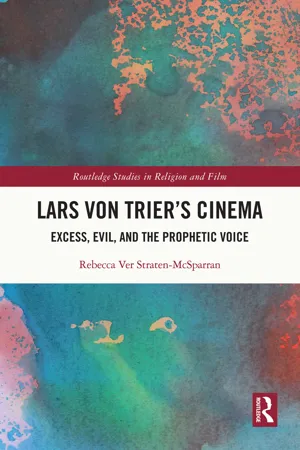Moses said to him, “Are you jealous for my sake? Would that all the LORD's people were prophets, and that the LORD would put his spirit on them!”
(Numbers 11:24–29 NRSV)
A grasp of biblical prophecy is indispensable for equating the films of Lars von Trier with this tradition, even analogically. It requires an examination of the source of prophecy, the person of the prophet, the prophetic message, and its effect. It is crucial in this context to be clear that the originary source of Old Testament (OT) prophecy is the Holy Spirit who speaks through the prophet, choosing when, where, and how to speak, and what to say. The prophet chosen is the right person for that time and place but should not be understood as synonymous with the message, for the prophet understands his role as a vessel, not the source, of biblical prophecy. Prophecy is not merely the provenance of moral righteousness or purity as understood by the Israelites. With each prophet, God has something new to say.
A common definition of the prophet mentioned earlier states: “A wide range of persons with diverse associations were called prophets because each in some way claimed to be communicating a divine message” (Smith 1986, 986). Prophets and prophecy appear throughout the Bible, from Genesis 20:7 to Revelation 22:6, the last chapter of the biblical canon, and in most canonical books, with the exception of Leviticus, Ruth, Esther, Job, Song of Songs, and some of the shorter epistles. A sampling of people labeled as prophets in Scripture reflects the diversity of the individuals called prophets: Abraham (father of the Hebrews), Moses (political leader), Aaron (priest), Asaph, Heman, and Jeduthun (musicians), Balaam (foreigner), Deborah (judge), Samuel (seer, priest, advisor), Elijah and Elisha (miracle workers), OT classical prophets (speakers, poet writers), Huldah (early prophetess), and false prophets. The threads of unity that connect them do not come from a common task, social standing, or vocation. With such a broad testament, is it possible to generate criteria for the category “prophetic?”
To answer this question, I limit the category of the prophetic to the classical prophets who emerged over a 300-year period, seeking to establish criteria for the category “prophetic” by locating the consistent marks of the prophets and their message. Although many scholars are hesitant to define consistent marks even within this category of prophets, or even to list commonalities between their messages (Blenkinsopp 1996, 26–27; von Rad 1967, 101), an examination of the etymology of the term “prophet” and discussion of the classical prophets—particularly their call, delivery, and content of their message—offers clear resources for defining the prophetic category. I then examine the prophet Ezekiel to illustrate the marks of the prophet, whose prophecy will later be analogically compared to the films of Lars von Trier. Last, I consider how we might situate these criteria for the prophetic category in the larger biblical context through an analysis of the prophetic in the NT.
Compared to the ancient role of priest and law in the history of Israel, the voice of the prophet as commonly understood is comparatively recent, first heard in the ninth century BCE. through Elijah and Elisha (von Rad 1965, 6–7). In early Hebrew history the word ro’eh, meaning “seer” is used for the prophet. Its root word, ra’a, means to see, perceive, or understand, and “seer” is biblically used to identify one who inquires of God and to whom revelation is given. Ro’eh disappears from usage early, but its interchangeable word hōzeh (visionary) is common until the third or fourth century BCE. Hōzeh is then interchangeable with the traditional Hebrew term designating the prophet, na’bi, meaning “spokesperson.” The na’bi is considered the “mouth” of God. In Deuteronomy 18:18 NRSV, the Lord says, “… and I will put my words in his mouth (na’bi), and he shall speak unto them all that I shall command him.” The prophet reports the word of God, proclaiming, “Hear the word of the Lord,” (Is 1:10; Hos 4:1; Amos 3:1), “Thus says the Lord” (1 Kin 20:13; 1 Chr 21:12), or by means of writing and sign-acts.
Although this language appears straightforward, the development of prophet and prophecy is so complex that it defies uniformity or the label of a movement (Blenkinsopp 1996, 27). Context plays a more important role in identifying a prophet or prophecy than does etymology, leading some to say that defining the terms or studying their etymology is unhelpful (Blenkinsopp 1996, 27; von Rad 1965, 5ff; Smith 1986, 986). At first blush, then, locating what makes a prophet a prophet appears discouraging if not illusory. Scholarship, however, is not a static enterprise. Prophecy arises as a religious category of study only in the nineteenth century with roots in early source criticism. What may generically be labeled “critical scholarship” of the classical prophets, seeking original words of the prophets through their historical and social context, has a complicated history (Barton, 1999, 348). The approach here is holistic, primarily a canonical approach to the prophets while still appropriating insight from critical scholarship, and an interpretive approach through poetic structures and conversation with contemporary culture.
